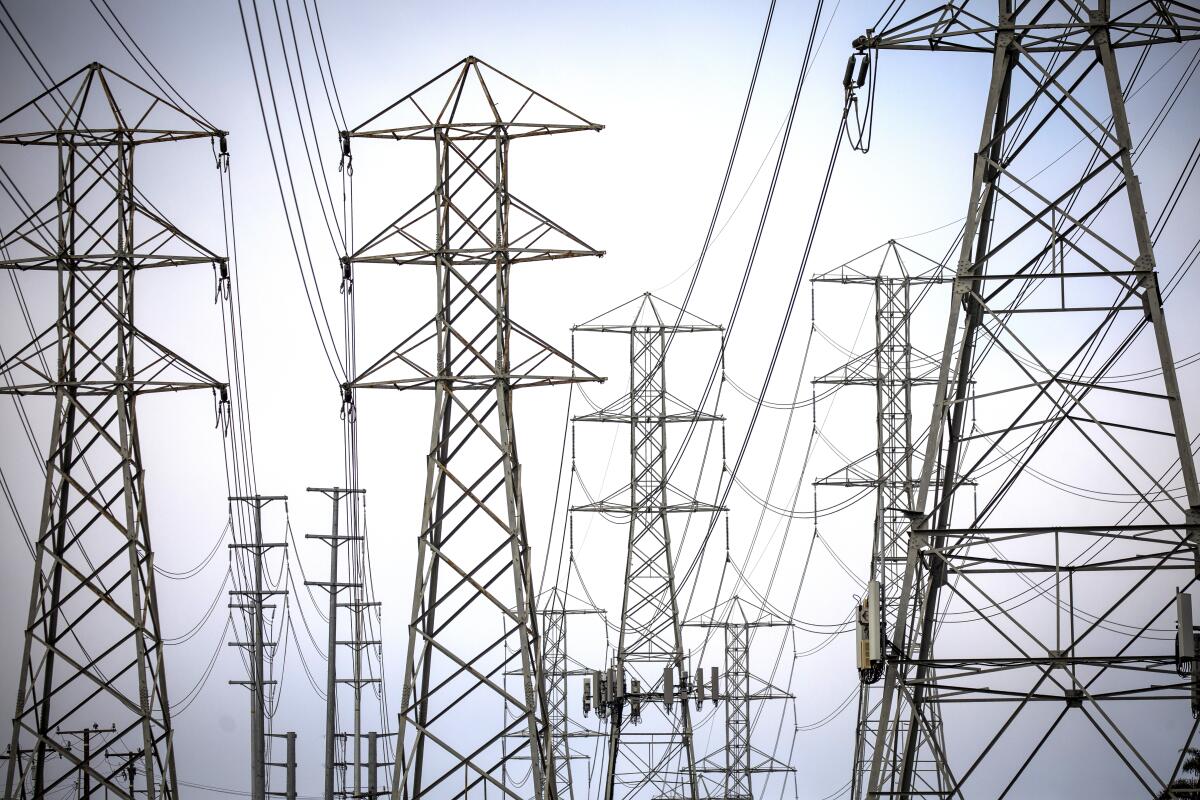Southern California electric bills are soaring. Here’s how to save money

- Share via
It’s no surprise that Southern Californians are seeing their monthly electricity bills surge this summer. As increasing rates have met with increasing temperatures, there have been anecdotal reports that, for some consumers, bills have skyrocketed, even by hundreds of dollars.
And Californians are looking for answers.
Why costs are rising
There are several factors that influence electricity prices across the United States, including the cost to build, finance, maintain and operate power plants and the electric grid, as well as weather conditions and state regulations, according to the U.S. Energy Information Administration.
In California, the driving force behind rate hikes is utilities recovering the cost of wildfire mitigation, transmission and distribution upgrades and rooftop solar incentives, according to a recent quarterly report by the California Public Utilities Commission’s Public Advocates Office.
Over the last 10 years, rates at California’s three big utility companies have risen as much as 110%, according to the report.
Layered on top of those climbing rates is an increase in energy use by customers amid excessive heat. And that’s the primary reason behind larger bills, said Gabriela Ornelas, spokesperson for Southern California Edison.
“The greatest impact we see on monthly bills is overall energy use,” Ornelas said.
Consumers have been moved to stay cool. Data from the National Centers for Environmental Information confirmed that last month was California’s hottest, with an average temperature of 81.7 degrees, surpassing the prior record from July 2021 by almost two degrees.
Amid the heat, the quarterly report stated the average monthly bill in July rose to $185 for Southern California Edison customers in the Greater Los Angeles area from $177.50 the month before.
Meanwhile, San Diego Gas & Electric had an average bill of $123, while Pacific Gas & Electric’s customers paid an average of $205. PG&E’s bill actually dropped from an average of $226.05 the previous month; reasons included recovery costs ending for certain past wildfires, according to Mary Flannelly, policy and communications advisor for the California Public Utilities Commission’s independent Public Advocates Office. She said that dip is likely a blip, though. “Future [rate] adjustments and rising costs” may drive rates back up, she said.
Some consumers have speculated that the larger electric bills are the result of a new rate plan that charges consumers based on when they use energy at home. Ornelas said that’s not necessarily true.
What is the time-of-use rate plan
Traditionally, customers paid for electricity based on their total consumption of energy every month. This is typically called a tiered rate plan.
By now, most California consumers, unless they opted out, have been transitioned to a time-of-use plan.
Implemented from 2020 to 2021, the plan offered by Southern California Edison, Pacific Gas & Electric and San Diego Gas & Electric was meant to align rates with the costs of producing electricity and reduce overall energy costs.
Consumers on time-of-use plans are charged based on when they use energy during the day, with seasonal changes. Each service provider has a similar baseline plan: During the summer months (June through September), the peak usage hours are from 4 to 9 p.m. During this high-demand time period, there is a higher cost for using electricity.
The rates are meant to encourage customers to shift their energy usage from periods when there is typically more demand on the electric grid and electricity is more expensive to produce, Ornelas said.
“We know 4 to 9 p.m. is usually when folks are returning from school, returning from work,” she said, “and we [understand] that some people need to use energy when they need it.” But they will pay a premium.
All three utility providers offer versions of the time-of-use plan. For example, one plan has peak hours from 5 to 8 p.m.; another is geared toward electric or hybrid car owners, who are encouraged to plug in during super-off-peak hours from midnight to 6 a.m.
To better understand which plan will best fit your energy use needs and your budget, visit your service provider’s website and use their plan comparison tool.
- Edison has an online comparison tool that offers plan estimates based on your past usage.
- San Diego has an online questionnaire that can help you compare rate plans.
- PG&E customers can compare electric rate plans by logging into their account.
How to cut your costs
Switching up your energy use habits can cut the cost of your bill, but you might need some reminding. You can sign up for Flex Alert notifications via text or email to help nudge you in the right direction.
Flex Alerts are typically issued a day ahead to help consumers plan out how to reduce their energy use during the summer peak hours. During those hours, if you can, avoid using larger electric appliances. Instead, use them in the morning or early afternoon.
The alerts also may be issued when there are unplanned power plant outages, when fires threaten or affect transmission lines or in the event of humid, hot weather and heat storms.
Reminder or not, there are a number of ways that you can reduce your energy use.
- Be smart about how you use your air conditioner. If you can’t avoid using it, let it run until your home is cooled down and then open the windows, but keep the window coverings in place to maintain the cool air.
- Or pre-cool your home in the morning. Adjust the thermostat to the low 70s then flip the A/C off so by the time the afternoon rolls around, and the heat starts to kick in, your home will remain somewhat cool, Ornelas said.
- Avoid using appliances that can heat up the house, such as the oven or stove top. Instead, enjoy the evening temperatures and grill your food outside.
- If you have the space, give your dryer a break and hang-dry your clothes.
- Get in the habit of charging your devices including laptops, phones and tablets before 3 p.m. or after 9 p.m. — avoid doing so during peak hours.
- When you’re not using an electronic device, unplug it. Or if they’re connected to a power strip, turn the strip off.
- If there are multiple TVs in your household, trying wrangling the family together for a movie night on one screen — or use one laptop. Better yet, scrap the screens altogether and dust off a board game, SoCal Edison suggests.
How to get assistance with monthly bills
Each utility provider has its own financial assistance programs and payment plan options for consumers.
SoCal Edison, PG&E and SDG&E all offer qualifying individuals or households 20% or more off their electricity bills. Eligibility is based on income and whether you or someone in the household is enrolled in certain public assistance programs. More information on Edison’s eligibility requirements are online. PG&E’s requirements can be found on its website, and SDG&E lists its information on its website as well.
The utilities also offer the Family Electric Rate Assistance program, which helps households of three or more with an 18% discount on their electric bills. More information on eligibility requirements can be found on each utility’s website.
These are just two programs; each utility offers discounted rate plans based on income and household size, payment plans and one-time bill assistance for eligible energy consumers.
More to Read
Sign up for Essential California
The most important California stories and recommendations in your inbox every morning.
You may occasionally receive promotional content from the Los Angeles Times.











